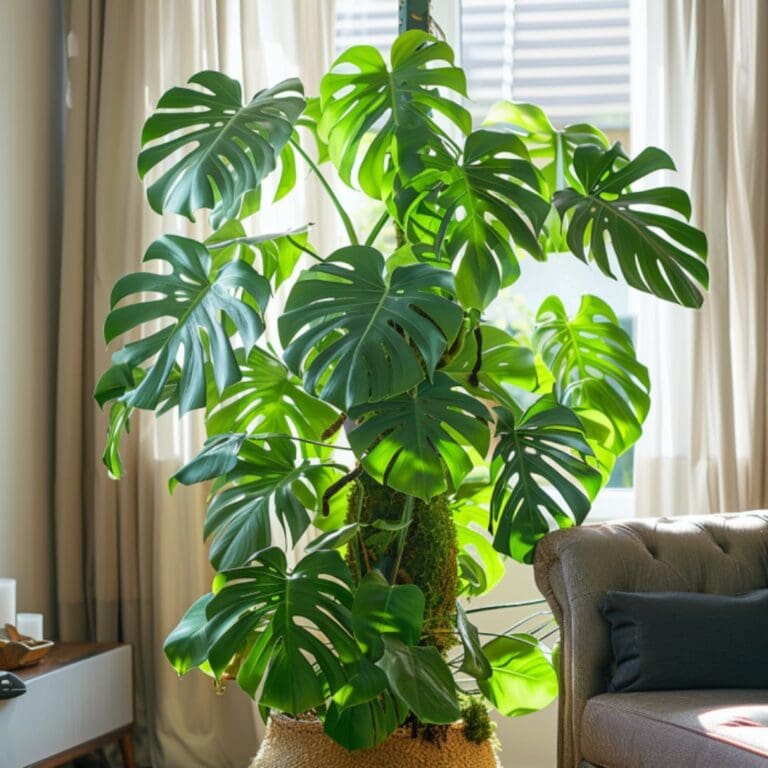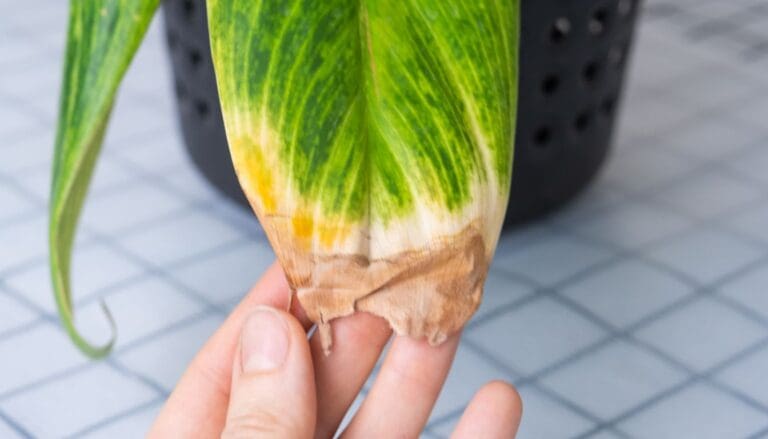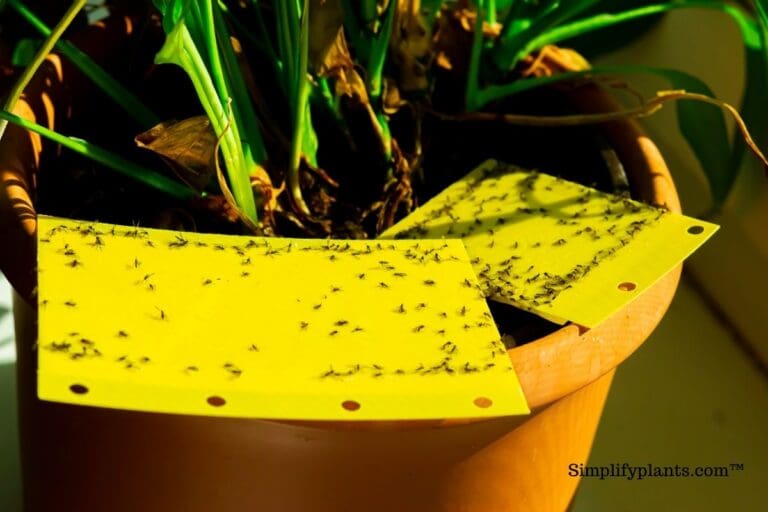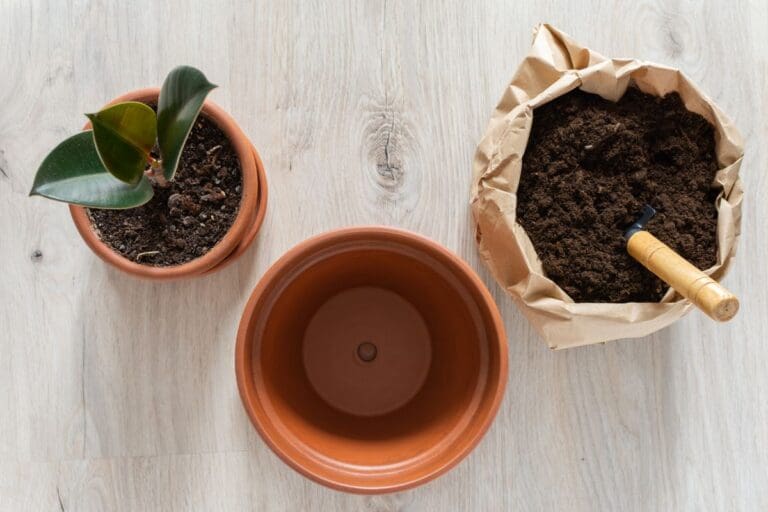Poinsettia Care Guide: Keep Your Festive Plants Thriving
Ever wondered how to keep your poinsettia vibrant and healthy indoors all year round? You’re not alone! Poinsettias are a holiday favorite, but with the right care, they can be a year-round beauty in your home.
The key to poinsettia care is maintaining the right temperature and light conditions.
I always make sure my poinsettias enjoy a cozy spot by a bright window with indirect light. 🌞 They thrive in temperatures between 65 and 75 degrees Fahrenheit.
Keeping them away from drafts and extreme temperature changes is a must.
A consistent, warm environment makes all the difference.
To keep your poinsettia blooming, it’s important to cut the stems back and repot them in mid-May. 💡
Use sterilized shears and fresh potting soil for the best results.
Watering well and placing them back in the brightest spot in your home brings them back to life.
Who knew poinsettias could be so rewarding? Share your own tips in the comments below! 🌿

Please note: Simplify Plants is reader-supported. As an Amazon Associate, I earn from qualifying purchases made by our readers with no extra cost added to you all! Some links in the post are affiliate links and I get a commission from purchases made through links in the post.
Basic Care Requirements
To keep your poinsettia thriving indoors, focus on light, temperature, watering, humidity, and fertilizing. 🪴
Light
Poinsettias need bright, indirect light to grow well. Place your plant near a sunny window, but avoid direct sunlight. Too much direct light can scorch the leaves, just like us getting a sunburn! 🌞
If you notice the leaves starting to fade or look unhealthy, it might be a sign that the plant needs more light.
You can use sheer curtains to diffuse the sunlight. How do you ensure your poinsettia gets enough light? Share in the comments! 💡
Temperature
These plants prefer moderate temperatures. Aim to keep your poinsettia in a spot where it’s between 65 to 75 degrees Fahrenheit during the day.
At night, a cooler temperature around 55 to 60 degrees Fahrenheit is ideal.
Be careful not to place your plant near drafts or heating vents. Sudden temperature changes can stress the plant.
Have you found the perfect spot in your home for your poinsettia? Let me know! 🌡️
Watering
Overwatering is a common mistake that can be fatal for poinsettias.
Water only when the top inch of soil feels dry to the touch. Use enough water to moisten the soil, but don’t let the plant sit in standing water.
A good trick: water the plant in the sink, let it drain completely, then place it back in its decorative pot. How do you gauge when it’s time to water your poinsettia? 💦
Humidity
Poinsettias enjoy moderate humidity levels. If the air in your home is too dry, the plant can suffer.
Mist the plant occasionally or use a humidifier to keep the air around it moist, especially in the winter when heating can dry out the air.
Does your home get really dry in the winter? How do you add humidity for your plants? 🌬️
Fertilizing
A balanced, water-soluble fertilizer is perfect for poinsettias. Apply it once a month during their growing season, which is spring and summer.
Look for fertilizers with an NPK ratio of 20-20-20 or 14-14-14.
Make sure to follow the instructions on the fertilizer package to avoid over-fertilizing. Have you found a specific fertilizer that works wonders for your poinsettia? Share your tips! 🌱
Potting and Repotting

When it comes to poinsettias, choosing the right soil and pot is essential for healthy growth. I’ll walk you through the soil requirements, how to choose the best pot, and the repotting process. Ready? Let’s get started!
Soil Requirements
For your poinsettia to thrive, good drainage is a must. I recommend using a loam-based soil mix with added perlite or sand. This keeps the soil from getting too soggy, which poinsettias hate. 🪴
Make sure the soil you use is also well-aerated. You don’t want your plant’s roots to suffocate!
A good rule of thumb is to lightly press the soil – if it feels compact, it’s too dense. Adding perlite helps keep things airy and light.
Remember, healthy soil is the foundation for a happy poinsettia!
Choosing a Pot
When picking a pot, size matters! Go for a slightly larger pot than the current one if you’re repotting. A pot that’s too big can lead to excess moisture and root rot.
Drainage holes are a must to prevent water from pooling at the bottom.
Opt for a pot that matches your home decor, too. 🌟 Who says practical can’t be pretty?
I like to choose pots that complement my living space, making the plant not just healthy, but also a nice visual addition.
Repotting Process
Here’s how I repot my poinsettia in a few simple steps:
- Remove the poinsettia: Gently take the plant out of its current pot. If it’s stuck, loosen the sides with a chopstick or similar tool.
- Prepare the new pot: Put some fresh soil mix at the bottom. Place the poinsettia in the center.
- Add soil: Fill around the plant with your chosen soil mixture. Make sure the roots are well-covered but don’t bury the stem too deep.
- Water well: Once potted, water the plant until it drains from the bottom. This helps settle the soil and gives it a nice drink.
Got any tips or fun pot ideas? Share in the comments below! 🌺✨
Growth and Pruning

Ensuring your poinsettia grows well indoors involves regular pruning and managing its growth. Let’s get our hands dirty with these easy tips! 🌿
Pruning Techniques
Pruning is like giving your poinsettia a haircut. ✂️
Start by trimming the stems back to about four inches in mid-May. This helps shape the plant and encourages new, healthy growth.
Use sharp, clean scissors to make cuts just above a leaf node or bud.
Don’t forget to remove any dead or weak branches. This will direct the plant’s energy toward stronger growth.
Remember, too much pruning can stress the plant, so be gentle. Have you pruned your plant lately?
Encouraging Bushiness
We all want our poinsettias to look full and lush, right? 🌟
To make the plant bushy, pinch back the growing tips when new growth appears. This forces the plant to branch out and become fuller.
Each pinch will encourage side shoots to develop, making your poinsettia look vibrant.
Another trick is to rotate the plant weekly. This ensures that all sides receive equal light and grow evenly.
Have you noticed one side growing faster? Give it a spin!
Dealing with Common Growth Issues
Sometimes our lovely poinsettias face challenges. Let’s tackle them head-on! 💪
Yellow leaves or leggy growth often mean the plant isn’t getting enough light. Make sure it’s placed in a spot with at least six hours of indirect sunlight.
Is your poinsettia looking stretched?
Overwatering can cause root rot. Check the soil before watering; it should be dry to the touch.
Watch for unwanted bugs. A quick spray with a mild soap solution can help keep pests away. Have you checked your plant for bugs lately?
With these tips, you can keep your poinsettia healthy and vibrant. Share your experiences in the comments below! 🌺
Pest and Disease Management

Taking care of poinsettias indoors means dealing with pests and diseases. It’s important to spot issues early and act quickly to keep your plants healthy.
Identifying Common Pests
Poinsettias can get some nasty visitors like whiteflies, spider mites, and fungus gnats. These little critters love to party on your plants, sucking sap and spreading trouble.
Whiteflies show up as tiny, white insects that fly around when you shake the plant. Spider mites are so small, they often go unnoticed until you see fine webbing. Fungus gnats look like tiny black flies and live in the soil.
Do you see any of these on your poinsettias? A good first step is to check under the leaves and around the soil regularly.
Disease Prevention and Control
Diseases like root rot and powdery mildew can also mess up your beautiful poinsettias.
Root rot usually happens if the soil stays too wet. The roots get mushy and black, and the plant might start wilting.
Powdery mildew looks like white dust on the leaves. It spreads quickly in humid conditions.
To protect your poinsettias, make sure they have well-draining soil and don’t overwater.
It’s also smart to avoid letting leaves get too wet. If you spot any powdery mildew, gently wipe it off with a damp cloth.
For root rot, check the plant’s roots often and repot if necessary.
If pests or diseases are overwhelming, sometimes natural treatments like neem oil or insecticidal soap can do the trick. Choose these options first before reaching for harsher chemicals.
Got any tips of your own? I’d love to hear them in the comments! 🌱🔍
Seasonal Care

Caring for a poinsettia varies throughout the year. It’s crucial to adjust your care methods based on the season to keep your plant healthy and vibrant.
Summer Care
In the summer, poinsettias enjoy being outdoors. I usually place mine in a shaded spot where they get indirect sunlight. Too much direct sunlight can scorch the leaves. 🌞
Moving the plant outdoors allows it to breathe and grow stronger.
Watering is essential during these hotter months. I make sure the soil stays moist but not soggy. Water when the top inch of the soil feels dry.
Adding a balanced, water-soluble fertilizer every two weeks can really help the plant thrive.
If you see any leggy growth, don’t hesitate to prune it. This encourages a fuller, bushier plant. Just be mindful to trim gently.
Winter Care
Winter is when poinsettias shine the brightest, often flaunting their brilliant red leaves. I keep mine in a spot where they can get plenty of bright, indirect light.
They love temperatures between 65 and 75 degrees Fahrenheit; anything too cold can cause damage.❄️
Watering is still important, but make sure the plant isn’t sitting in water. Water thoroughly until it drains out, then discard any excess water in the saucer.
They enjoy a bit of humidity, so misting the leaves occasionally can help. You could use a humidifier if your home is particularly dry.
Don’t forget to keep the plant away from drafts and heat sources like fireplaces or vents. This ensures it stays cozy and continues to look stunning throughout the holidays.
Encouraging Blooming
Blooming can be a bit tricky, but with some effort, your poinsettias can bloom beautifully year after year.
Starting in September, I place mine in complete darkness for about 14 hours every night. A cardboard box or a dark closet works well for this.
During the day, I make sure it gets bright, indirect light.
This light and dark routine should continue for about 8 weeks.🌼
One key thing is to maintain night temperatures around 60 degrees Fahrenheit.
Patience is key here. With this method, by late November or early December, your poinsettia should start to show those iconic colorful bracts.
Troubleshooting Common Problems

Poinsettias are lovely holiday plants, but they can have their share of issues. Let’s tackle some common problems like leaf drop, wilting, and color fading! 🌿
Leaf Drop
Ever had your poinsettia suddenly shed its leaves? This could be due to temperature changes or drafts.
Poinsettias thrive at 60-70°F during the day and slightly cooler at night. Keep them away from chilly windows or heating vents.
Sometimes, it might be a watering issue. Over-watering causes roots to rot, while under-watering dries them out.
I suggest a balanced approach: water when the top inch of soil feels dry. 🌱
Lastly, lack of light can also be a culprit. Make sure they get plenty of indirect sunlight; about 6 hours a day is perfect!
Wilting
Wilting plants can be a major bummer. 😟 This is often due to watering problems.
High-quality, well-draining soil is essential. Using a pot with drainage holes can prevent waterlogging.
Temperature stress is another factor. Ensure your poinsettia isn’t exposed to hot or cold drafts. Consistent room temperature is key.
If wilting continues, your plant might be in a pot that’s too small. Repotting into a slightly larger container can help. A fresh start can work wonders! 🌺
Color Fading
Is your poinsettia losing its iconic red color? This usually happens due to insufficient light. These plants need bright, indirect light to maintain vibrant colors. 🕶️
Temperature again plays a role here. Temperatures below 55°F can cause fading. Make sure to keep them at a cozy but not too hot 60-70°F.
Lastly, ensure you don’t over-fertilize. Too much fertilizer can make the leaves turn green.
Use a balanced, water-soluble fertilizer once a month, in moderation. Less is more!
Propagation
Let’s learn how to propagate your poinsettia plants with ease! I’ll cover both the cutting method and the seeding method to help you expand your poinsettia collection.
Cutting Method
For the cutting method, you’ll need a healthy stem from your poinsettia.
Start by selecting a stem about 8 inches long from a vigorous plant. Make a clean cut near the base of the stem. Remove the lower leaves, leaving two or three at the top. This helps encourage root growth.
Next, dip the cut end in rooting hormone to boost root development.
Place the cutting into moist, fertile soil, ensuring at least half an inch of the stem is below the soil surface.
Water it well, and place it in a bright spot. Keep the soil moist, but not soaked, to prevent rotting.🌿
New roots should start to form in a few weeks. Once they do, you’ll see new growth at the top, proving your cutting is taking root! Exciting, right?
Give it time, and soon you’ll have a brand new poinsettia plant ready to brighten up your home.
Seeding Method
To propagate poinsettias from seeds, start by collecting seeds from the plant. If your plant is blooming, you may notice small seed pods forming. Wait until they are mature before collecting them.
Plant the seeds in well-draining potting soil. Cover lightly with soil and water gently.
Keep the soil moist and place the pot in a warm, sunny spot. The seeds need consistent warmth for germination. 🌞
It might take a few weeks for the seeds to sprout. Be patient!
Once they start to show little green shoots, continue to keep the soil moist.
Thin out the weaker seedlings to give the strong ones space to grow.
FAQs
How often should I water my poinsettia?
I water my poinsettia when the top 50% of the soil feels dry. Slowly pour water until it starts draining out. Don’t forget to dump excess water after a few minutes!
What temperature is best for my poinsettia?
Poinsettias like it warm. I keep mine between 65-75°F during the day. At night, a slightly cooler temperature is okay, but I avoid drafts.
How much light does my poinsettia need?
I give my poinsettia lots of light. I place it near my brightest window but avoid direct sunlight for too long. It’s a balance!
Can I repot my poinsettia?
Yes, you can! I repot mine in mid-May into a slightly larger container with fresh soil. It helps the plant stay healthy and grow better.
Why are the leaves on my poinsettia falling off?
Leaf drop can happen from too little light, inconsistent watering, or cold drafts. I make sure to keep a stable environment and monitor my watering schedule closely.
Should I fertilize my poinsettia?
I use a balanced houseplant fertilizer during the growing season, from spring through summer. This gives my plant the nutrients it needs to thrive.
How can I get my poinsettia to re-bloom?
To re-bloom, I keep my poinsettia in total darkness from 5 PM to 8 AM starting in October. This simulates the natural light cycle it needs to produce those vibrant bracts!
Do poinsettias need high humidity?
My poinsettia enjoys humidity levels between 50% and 75%. In dry climates, I use a humidity tray or a room humidifier to keep my plant happy.
Is my poinsettia safe around pets?
Caution! Poinsettias can be mildly toxic to pets. I keep mine out of my pets’ reach, just in case.
Got any more questions about poinsettias? 🌺 Drop them in the comments, and let’s chat! 😊
Conclusion
Taking care of a poinsettia indoors is easier than it seems. Just follow the right steps! 🌿
First, light is key. Place your poinsettia near the sunniest window in your home.
Poinsettias love bright, indirect light.
Watering can be tricky. Don’t overwater!
The top inch of soil should feel dry before you water again. Trust me, your plant will thank you!
Temperature matters too.
Keep your poinsettia in a warm room, between 65-75°F (18-24°C).
Drafts or extreme temperature changes can cause stress to the plant.
Think about humidity as well.
Poinsettias prefer a bit of moisture in the air.
You can use a pebble tray or a humidifier if your home’s air is too dry.
A little pruning helps too.
Trim the stems back to about 4 inches in mid-May.
This keeps your poinsettia looking its best and encourages new growth.
Don’t forget to repot your plant.
Choose a slightly larger container with fresh potting soil in mid-May also.
Fresh soil gives your poinsettia the nutrients it needs.
Lastly, be patient. With the right care, your poinsettia will thrive beyond the holidays. 🌺
Got some tips or questions about poinsettia care? Drop them in the comments below! Let’s help each other grow amazing plants. 🌿💬
Recommended Garden Supplies
| Product Image | Our Recommended Gardening Supplies | Check Offers! |
|---|---|---|
Top Top
Top
Top
Top
Top
Top
Top
Top | rePotme Houseplant and Tropical Classic Potting Soil Mix | Check Offer On Amazon |
 Top
Top
Top
Top
Top
Top
Top
Top | Espoma Organic Indoor Plant Food | Check Offer On Amazon |
 Top
Top
Top
Top
Top
Top
Top
Top | GooingTop LED Grow Light 6000K Full Spectrum Clip Plant Growing Lamp | Check Offer On Amazon |
 Top
Top
Top
Top
Top
Top
Top
Top | Soil Moisture Meter | Check Offer On Amazon |
 Top
Top
Top
Top
Top
Top
Top
Top | Govee Hygrometer Thermometer, Bluetooth Enabled! | Check Offer On Amazon |
 Top
Top | LEVOIT Humidifiers for Large Room(Best For Plants) | Check Offer On Amazon |
 Top
Top
Top
Top
Top
Top
Top
Top | Upgraded DIY Automatic Drip Irrigation Kit, 15 Potted Houseplants Support | Check Offer On Amazon |
 Top
Top
Top
Top
Top
Top
Top
Top | Stainless Steel Heavy Duty Gardening Tool Set | Check Offer On Amazon |
 Top
Top
Top
Top
Top
Top
Top
Top | Bonide Insecticidal Soap | Check Offer On Amazon |
 Top
Top
Top
Top
Top
Top
Top
Top | Bonide 32 oz Spray Neem Oil for Organic Gardening | Check Offer On Amazon |
 Top
Top
Top
Top
Top
Top
Top
Top | Garden Safe Fungicide | Check Offer On Amazon |







